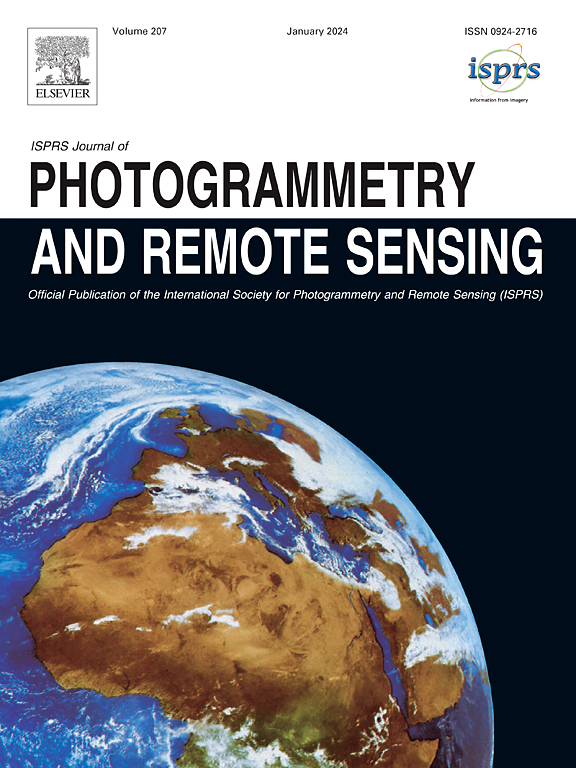VecMapLocNet: Vision-based UAV localization using vector maps in GNSS-denied environments
IF 10.6
1区 地球科学
Q1 GEOGRAPHY, PHYSICAL
ISPRS Journal of Photogrammetry and Remote Sensing
Pub Date : 2025-05-09
DOI:10.1016/j.isprsjprs.2025.04.009
引用次数: 0
Abstract
Vision-based localization techniques are effective UAV localization solutions for GNSS-denied conditions, however they depend on costly, complex, and seasonally variable satellite images or 3D maps, whereas humans can determine location using vector maps. Inspired by human navigation strategies, we propose VecMapLocNet , which uses vector maps to determine UAV 3-DoF poses (latitude, longitude, and yaw) through cross-modal matching. Three key modules are designed to improve the matching between UAV images and vector maps. The UAV feature extraction module is low-latency and adaptable to various flight altitudes, ensuring it is suitable for airborne deployment. The vector map feature extraction module employs a weighted representation of different map elements, ensuring robustness against changes in visual appearance. Inspired by Fourier transforms, the feature matching module for 3-DoF pose estimation is parameter-free, computationally efficient, and invariant to cross-modal differences. To evaluate VecMapLocNet, we introduce a comprehensive dataset that presents challenges, encompassing seven cities worldwide. Through rigorous experimentation, VecMapLocNet has demonstrated competitive performance compared to existing methods in localization accuracy (84.45% Recall@5 m), yaw estimation (88.61% Recall@5°), and computational efficiency (25.23ms latency on onboard device Jetson Orin). Furthermore, we validated VecMapLocNet’s performance in real-world scenarios, with experimental results confirming its generalization ability, achieving a localization error of 16.7 m and an orientation error of 3.1°. The code and datasets are available at https://map.geovisuallocalization.com.

VecMapLocNet:在gnss拒绝的环境中使用矢量地图进行基于视觉的无人机定位
基于视觉的定位技术是gnss拒绝条件下有效的无人机定位解决方案,然而,它们依赖于昂贵、复杂且随季节变化的卫星图像或3D地图,而人类可以使用矢量地图确定位置。受人类导航策略的启发,我们提出了VecMapLocNet,它使用矢量地图通过跨模态匹配来确定无人机的3-DoF姿态(纬度,经度和偏航)。为了提高无人机图像与矢量地图的匹配,设计了三个关键模块。无人机特征提取模块是低延迟和适应各种飞行高度,确保它适合空中部署。矢量地图特征提取模块采用不同地图元素的加权表示,确保对视觉外观变化的鲁棒性。受傅里叶变换的启发,用于3-DoF姿态估计的特征匹配模块是无参数的,计算效率高,并且对跨模态差异不变化。为了评估VecMapLocNet,我们引入了一个全面的数据集,其中包含了全球七个城市的挑战。经过严格的实验,VecMapLocNet在定位精度(84.45% Recall@5 m)、偏航估计(88.61% Recall@5°)和计算效率(在机载设备Jetson Orin上延迟25.23ms)方面表现出了与现有方法相比的竞争力。此外,我们在实际场景中验证了VecMapLocNet的性能,实验结果证实了其泛化能力,实现了16.7 m的定位误差和3.1°的方向误差。代码和数据集可在https://map.geovisuallocalization.com上获得。
本文章由计算机程序翻译,如有差异,请以英文原文为准。
求助全文
约1分钟内获得全文
求助全文
来源期刊

ISPRS Journal of Photogrammetry and Remote Sensing
工程技术-成像科学与照相技术
CiteScore
21.00
自引率
6.30%
发文量
273
审稿时长
40 days
期刊介绍:
The ISPRS Journal of Photogrammetry and Remote Sensing (P&RS) serves as the official journal of the International Society for Photogrammetry and Remote Sensing (ISPRS). It acts as a platform for scientists and professionals worldwide who are involved in various disciplines that utilize photogrammetry, remote sensing, spatial information systems, computer vision, and related fields. The journal aims to facilitate communication and dissemination of advancements in these disciplines, while also acting as a comprehensive source of reference and archive.
P&RS endeavors to publish high-quality, peer-reviewed research papers that are preferably original and have not been published before. These papers can cover scientific/research, technological development, or application/practical aspects. Additionally, the journal welcomes papers that are based on presentations from ISPRS meetings, as long as they are considered significant contributions to the aforementioned fields.
In particular, P&RS encourages the submission of papers that are of broad scientific interest, showcase innovative applications (especially in emerging fields), have an interdisciplinary focus, discuss topics that have received limited attention in P&RS or related journals, or explore new directions in scientific or professional realms. It is preferred that theoretical papers include practical applications, while papers focusing on systems and applications should include a theoretical background.
 求助内容:
求助内容: 应助结果提醒方式:
应助结果提醒方式:


